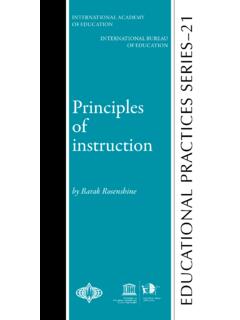Transcription of Worksheet Usage, Reading Achievement, Classes Lack of ...
1 international Journal of education in Mathematics, Science and Technology Volume 2, Number 2, April 2014, Page 96-106 ISSN: 2147-611X Worksheet Usage, Reading Achievement, Classes Lack of Readiness, and Science Achievement: A Cross-Country Comparison Che-Di Lee* National Taiwan Normal University Abstract Instructional written materials play important roles as teachers agents in effective teaching practices. Worksheets are one of the most frequently used materials. In this exploratory study, the relationships between Worksheet usage and science achievement in 32 countries were examined through the use of TIMSS and PIRLS data and multiple regression analysis. Based on two dimensions, five types of relationships among science achievement, Worksheet usage, and other related variables are identified. The first dimension is whether the status of significance in the association of worksheets used as a basis and science achievement changes before and after controlling four teacher and school variables: schools emphases on academic success, safety and orderliness of school, teachers confidence in teaching science, and instructional engagement of students.
2 The second dimension is the interaction of worksheets as a basis and Classes lack of readiness. The interaction between worksheets as a basis and Reading achievement in science achievement is found to be not significantly different from zero in all participating countries. Four directions of further investigation are suggested based on the results. Key words: Science education , Worksheets, Elementary education , Secondary analysis Introduction Worksheets have been used in teaching practices for a long time. In modern time, worksheets have even become a driving force of curriculum in some countries (Lesley & Labbo, 2003; Martin, Mullis, Foy, & Stanco, 2012; Reid, 1984). Anderson et al. (1985) reported that in 1985, thousands of elementary students in the United States completed approximately 1,000 worksheets per person to acquire literacy in a school year. Teachers use worksheets for the purposes of supporting studying, promoting active learning, raising interest in learning science, and assessment.
3 Many studies suggest that well-designed worksheets have had positive impacts on students learning achievement (Sasmaz-Oren & Ormanci, 2012). However, researchers observed that there were many inappropriately designed and misused worksheets that hindered learning (Lesley & Labbo, 2003). In this exploratory study, the relationships between Worksheet usage and science achievement in 32 countries are examined. Worksheet and Achievement Worksheets can be useful in many ways in terms of academic achievement. For example, as supplements to textbooks, worksheets can be used to add information for particular Classes . In addition, blanks in worksheets are invitations for students to fill in gaps; they are opportunities for knowledge construction. Well-designed questions in worksheets can draw students interest when paired with proper teaching methods. Furthermore, worksheets play a variety of functions in different contexts.
4 McDowell and Waddling (1985) suggested that during laboratory investigations, properly designed worksheets can help teachers overcome the problems of time demanding and enable teachers to enhance students acquisition of knowledge and skills. Kisiel (2003) pointed that in activities while visiting museums, worksheets can function as advance organizers, helping students to organize their observations and knowledge in a confusing learning environment. Krombab and Harms (2008) concluded that worksheets are effective in helping students aged 11 15 to acquire knowledge such as * Corresponding Author: Che-Di Lee, 96 Lee biodiversity in a natural history museum because they can structure the visit, keep students attention on certain objects, and form a basis for follow-up coursework. As an assessment tool, worksheets can be used by teachers to understand students previous knowledge, outcome of learning, and the process of learning; at the same time, they can be used to enable students to monitor the progress of their own learning.
5 In order to ensure Worksheet s effectiveness, many studies focused on the design of worksheets (Campbell, 1999; Hoener, Salend, & Kay, 1997; Sasmaz-Oren & Ormanci, 2012). The basis for successfully transferring message to students is layout. To enhance teachers abilities to design worksheets, Rotter (2006) proposed the layout principle COLA (contrast, orientation, lettering, and artwork). In worksheets, characteristics of questions are important factors. Calderhead et al. (2006) demonstrated that the arrangement of items with different levels of cognitive difficulty can affect students learning results. Formats of information, or scaffolds, in worksheets are also of concern to educators. For instance Wolf et al. (2010) devised three formats of critical thinking tools to promote conceptual understanding in physical geography and Ueckert and Gess-Newsome (2008) advocated for a conceptual flow graphic to make active learning possible.
6 In addition to the positive impacts of worksheets on academic achievement, there are negative impacts. Lesley and Labbo (2003) argued that mass-produced worksheets are not helpful for achieving educational goals. Although the worksheets they observed were focused on literacy learning, their findings can still shed some light on Worksheet usage for science learning. According to their remarks, the aspects of Worksheet problems included the format of texts ( , that the print and the spaces allotted for students to write in are too small); Reading demand ( , that the language of instruction was too complex and required teacher explanation); openness of questions, some of which offered only one correct way to respond and could not reward students for their natural curiosity; the challenge of tasks ( , that tasks were boring or designed for practicing skills repeatedly instead of making students learn new strategies or techniques), and the relationship between students interests and tasks.
7 In addition to the quality issues, as students completing worksheets, their cognitive processes can also make worksheets invalid. Ueckert and Gess-Newsome (2008) noted that students use a word-matching strategy match words in questions with the corresponding sentences in the textbook, and this keeps them in a passive learning status. Worksheet , Reading Achievement, and Science Achievement Worksheets are a kind of written material, so Reading demand may be a barrier to students with low Reading abilities. Researchers suggested that teachers should use easier language to support students (Rix, 2006). For example, O Leary (2011) designed a format of worksheets with low average Reading difficulty. Questions in the beginning are carefully matched with low Reading ability students and subsequent questions require increasing levels of literacy. The result showed that this kind of worksheets can improve student engagement and on-task behavior during independent Worksheet activities.
8 There are a number of factors contributing to Reading difficulty, such as organization of materials, syntax, word length, sentence length, word frequency, typeface, and line spacing (Department of education and Science, 2007; Meyer, 2003; O Leary, 2011). If teachers carefully control these factors and use available readability formulas to reduce the Reading demand, or offer oral explanations to words in worksheets, the association between Worksheet usage and science achievements will be the same regardless of students Reading achievements. The debate about the difficulty of language used in worksheets has been raised in literature (O Leary, 2011). Some researchers insist that easy language negates worksheets abilities to challenge students and offer opportunities of language acquisition (Hayes, Wolfer, & Wolfe, 1996). In addition, although there are rules for controlling the Reading demand, according to Reid s (1984) study, only about 30% of Worksheet writers checked readability despite knowing that it is the essential.
9 Under this kind of condition, students with low Reading abilities have problems completing worksheets and the associations between Worksheet usage and science achievement therefore differ among students with different Reading levels. Worksheet , Lack of Readiness, and Science Achievement According to Reid (1984), teachers tend to use worksheets with low-achievement Classes . The reasons for this tendency may be twofold. One is that textbooks are designed for general students and need to be adapted. However, worksheets can offer relevant questions and motivate students, both of which are functions that were ranked as best performed by teachers surveyed in the Reid s (1984) study. Secondly, as written material, worksheets are able to act as agents of teachers to lead students attentions and give students opportunities to work independently, so the students can work at their own paces and the teacher can have time to take care of those students who need more help (McDowell & Waddling, 1985).
10 97 IJEMST ( international Journal of education in Mathematics, Science and Technology) If worksheets are properly designed and used, they can support students thought. However, many teachers are concerned by the repetitive nature of worksheets, the risks of student boredom, and a lack of the pedagogical knowledge and skills required to prevent children from thinking insufficiently before completing worksheets (Reid, 1984). These factors may cause failure in the application of worksheets in Classes lacking readiness. Research Questions The purpose of this study is to explore the association between Worksheet usage and science achievement in grade four students across the countries in the fifth cycle of the Trends in international Mathematics and Science Study (TIMSS 2011) and the third cycle of the Progress in international Reading Literacy Study (PIRLS 2011). To gain an overview of the association , the first question that arises is: Is there difference in science achievement between situations in which worksheets are used as a basis for instruction and those in which they are used as supplements, and between those in which they are used as supplements and those in which they are not used?













